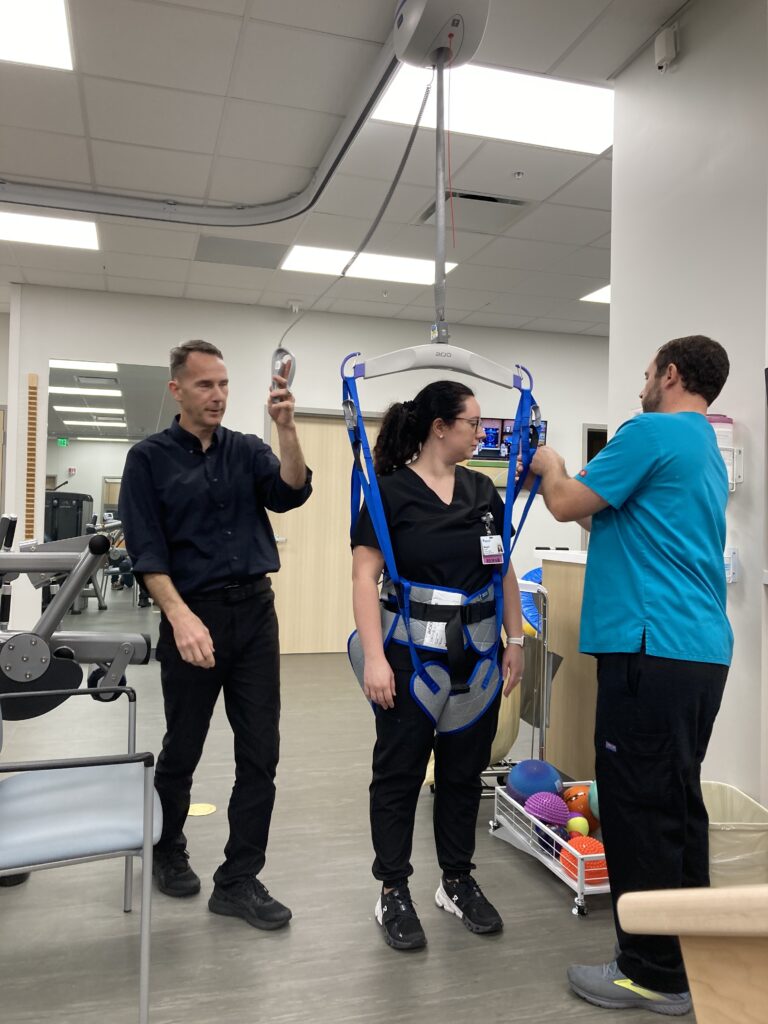
STATE-OF-THE-ART FACILITY CAN MEET EVERY NEED.
“We just want people to know they don’t have to drive to Tampa to get state-of-the art care—that we can provide state-of-the art outpatient rehabilitation in the areas of physical therapy, occupational therapy, and speech therapy right here in Plant City,” Rehabilitation Supervisor Jennifer Ackett said.
The facility in the new South Florida Baptist Hospital offers 20 therapists onsite to meet the needs of Plant City and surrounding areas. The team has several very experienced therapists, so SFBH was able to call upon years of knowledge that was used to design the rehabilitation center. The clinic is equipped to handle people of every size, shape, and medical diagnosis.
“The most exciting thing is, whether they are learning to speak again, or walk again, the patients get excited because now they are getting to do what they used to do,” Occupational Therapist David Davenport said. “And we are the accelerant for that.”
The center has some equipment rarely found in other facilities. For example, the parallel bars are remote controlled. They can be adjusted up and down, or in and out, at any time. The advantage is, when the bars need to transition between different heights and body types, instead of spending time messing with equipment, the equipment rapidly changes without effort from the clinician. “The big point is the clinician can spend more time with the patient,” Davenport said. “And the parallel bars are infinitely adjustable because there are so many different body types and sizes, and we are all different heights. So, when you are trying to work on your balance and your gait—trying to get your walking better, the last thing you want to be concerned about is something you’re holding on to.”
One of the coolest things about the center is a ceiling track that runs above the parallel bars, over stairs, and around the edge of the equipment area. A harness is attached to a lanyard hanging from the track. The system is for people ready to start taking steps, but who can’t do it unsupported. If they stumble, the system will hold them up. “The track the patient can walk is very dynamic in that we have the ability for them to try steps with varied heights; we have two sets of parallel bars; and we have the opportunity for patients to get on and off the bed,” Davenport said. “So, it is really open to meet the varying needs of the public.”
Another rare piece of equipment is an anti-gravity treadmill. Patients can get in a seat and get zipped in like in a kayak. This treadmill lowers patients’ impact weight by up to 80 percent so they can work on weaknesses, hip or knee replacements, or injuries. The feel is more natural than therapist hands-on support, and it is great at giving patients appropriate confidence with their mobility. The anti-gravity treadmill allows the therapist to give attention to other aspects of treatment to accelerate a patient’s recovery. Athletes also use this equipment to strengthen an injury by avoiding the pounding that happens when they run at their full weight.
The center also offers a variety of specialty programs that doctor’s office staff have said, “We’ve been looking for that,” or, “It’s hard to find that.” Among these is a free neuro support group led by a certified neurotherapist with over 30 years of experience; a free monthly aphasia support group; and SpeakOut! a group for people with Parkinson’s to maintain or improve their voice and swallowing.
“We specially designed two of our speech therapy rooms—they are soundproof so that the patient has more privacy for vocal exercises that can be loud,” Ackett said. “The rooms are also great for therapy for those with cognitive impairment so they don’t get distracted.” These rooms also have specialty equipment for voice and swallowing. Among these is one that gives speech therapists the option to conduct a fiber-optic endoscopic evaluation of swallowing. “These are the largest, most equipped rooms for speech therapy I have ever seen in any clinic, and I have been doing this for 30 years,” Davenport commented.
“One thing I see patients are happy about when coming here is the personal service, the one-on-one care, and the individual service that they get,” Ackett said. “They don’t just get set on a piece of equipment and left while a therapist works with three other people.”
“I would say that is just how the hospital is because it is so connected to the community,” Communications Coordinator Cherié Miller commented.
“Yes—this is our community,” Ackett added.
